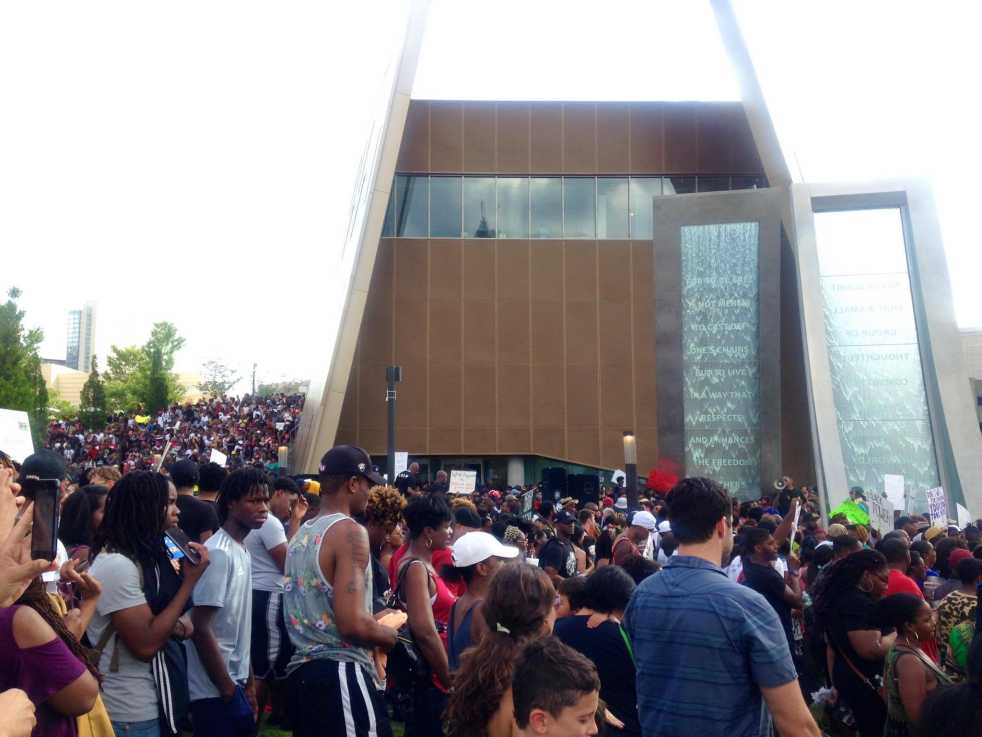Protesters have taken to the streets of Atlanta for five consecutive nights in the wake of police shootings and retaliatory attacks across the country.
Two black men, Alton Sterling and Philando Castille, were shot and killed by police officers in incidents which were captured on camera and circulated on the internet. Following this, on July 5 and 6, Black Lives Matter protests and occupations began to surface in major cities such as Chicago, St. Paul, Minn. and New Orleans. On July 7, a sniper targeted police forces monitoring a protest in Dallas, killing five officers and wounding seven. Protest movements have continued nationwide in the days since amid ongoing discussion of the role of policing in racial issues.
Protests in Atlanta peaked on July 8 as approximately 10,000 people participated in marches and events around the city. That evening saw a group of hundreds occupy the Downtown Connector, briefly blocking traffic along the freeway between North Avenue and Spring Street.
GA Code § 32-6-1 (2015) states that “(a) It shall be unlawful for any person to obstruct, encroach upon, solicit the sale of any merchandise on, or injure materially any part of any public road.” Demonstrators and protesters may wish to expand the reach of their message by moving their activities onto the roadways but need to realize they are in violation of the law when they do so. These laws have a clear purpose for keeping everyone safe; motorists who are not aware of the protests will not be prepared and therefore cannot be expected to behave accordingly.
Those carrying out the demonstrations are also in danger. Without any type of publicly-sanctioned organization, there is a high likelihood that demonstrators may engage in less-than-safe methods of demonstration when roadways are concerned. Though it may be difficult in times of tension, open communication between protesters and local law enforcement is critical to ensuring the safety of those involved with the demonstration and bystanders alike.
Atlanta Mayor Kasim Reed expressed his sentiments in a statement made Monday on his Facebook page. In it, he discussed how those comparing the marches of Dr. Martin Luther King Jr. to the demonstrators attempting to block streets in Atlanta are misguided. Reed stated that Dr. King’s marches were done after long periods of planning and coordination with public officials and that this has not been the case with the current protests, which “put innocent motorists’ lives at risk without warning.”
Further protests since Friday night have spanned much of Atlanta, from Midtown and Centennial Park to Buckhead. Eleven arrests were made the following evening, ten for pedestrian obstruction of roads in Midtown and one for disorderly conduct. In spite of these arrests, Atlanta remains one of the most peaceful cities during this period of protest, with far fewer arrests and clashes with police than regions such as Baton Rouge and the Twin Cities. Riot gear and other extreme tactics have thus far not been deemed necessary by the Atlanta Police Department (APD), though Mayor Reed has stated that he will consider calling the National Guard as well as instituting a curfew to accommodate an eventual exhaustion of APD resources.
Though Tech students are often reputed to have little interest in political engagement, many have participated in local demonstrations over the past week.
Angel Edwards, second-year IAML, attended demonstrations on July 8 and 9. “Seeing a unified, diverse group of people gave me hope … The white people that came as allies were encouraging, but I believe there is need for more of a presence of white people. They were very much a minority in the protest. As it pertains to race, the oppressed cannot be fully uplifted without the help, voice and actions of the privileged.”
“I went to two [demonstrations]: one in Centennial Olympic Park and one at Lenox Square,” said Zach Connolly, second-year IE. “For Lenox, my friend Aurielle Marie was an organizer and speaker, and she did very well. She organized the [demonstration] where the mayor came out and spoke to [protesters]. And for that one, there were a ton of cops; two paddy wagons, patrol cars, motorcycles, everything — there must’ve been over 75 cops. White people … voluntarily made a barrier between the people of color and police to keep safe. But they still started arresting people for being in the road, which caused a lot of unrest.
“The Centennial Olympic Park [(COP)] one was organized by the NAACP, and cops were on the perimeter of the march but never came in. There must’ve been over 8,000 protesters.
“Both were amazing. They gave me chills and made me feel like we were really doing something. The most powerful was sitting in front of Lenox entrance, along with the screaming heard for miles on end at COP, [which] gave me chills every time it started.”
